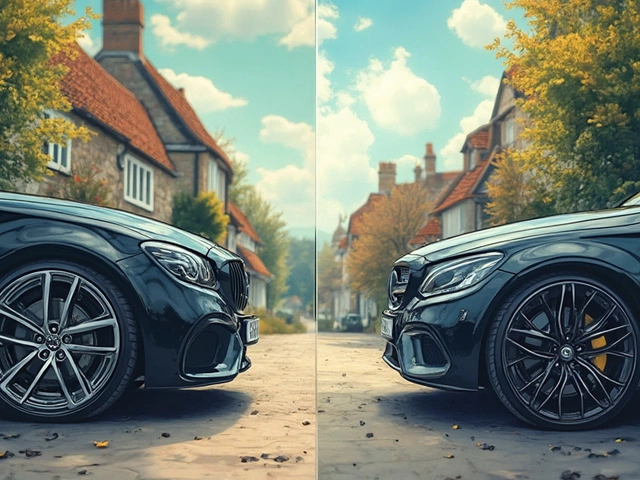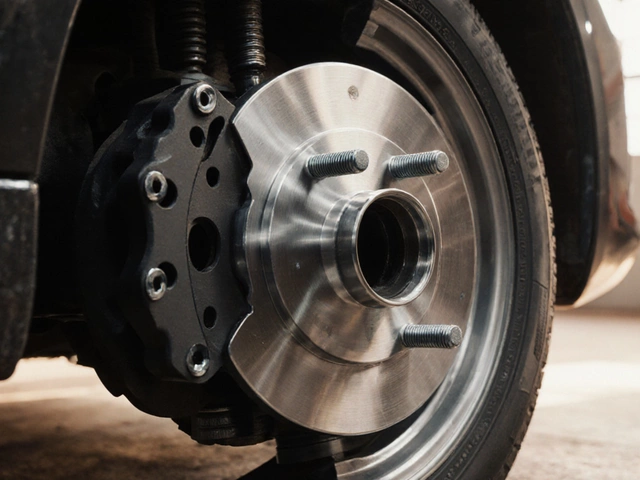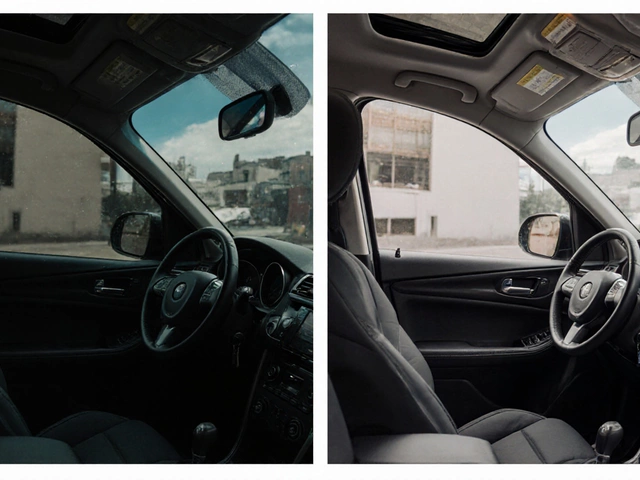Ever driven at night and felt like you’re squinting through sunglasses? That's what happens when your tint is too dark or the wrong kind. The right window tint can cut down on headlight glare, but go even a shade too dark and you’re in trouble. You need to get the balance just right if you want to actually see where you’re going.
Most people don’t realize that tint doesn’t just block out sunlight; it also reduces how much you can see when it’s already dark outside. State laws usually limit how dark you can go, but you’ll still see plenty of cars out there with almost limo-black windows. Trust me, that’s begging for a ticket—and a headache when it comes to nighttime visibility.
Here’s a simple rule that works almost everywhere: stick to 70% visible light transmission (VLT) or lighter for your front windows. This means your tint still lets in 70% of light. Anything darker will start to mess with your night vision, especially if you’re already fighting glare or rain. Don’t just slap any old film on your ride. Some tints are specifically designed to reduce glare without killing your visibility. Ceramic and crystalline films are a step above the basic dyed stuff, and you’ll see it right away—less eye strain, more confidence rolling through the dark.
- Why Tint at Night Is Tricky
- Best Tint Shades for Night Driving
- Legal Stuff You Should Know
- Extra Tips for Safer Night Vision
Why Tint at Night Is Tricky
When you’re deciding on tint for your car, it’s easy to get caught up in how it looks in the daytime. But nighttime is when things get complicated. The biggest problem? Most tints cut down on how much light gets inside, which is fine under bright sun but a real pain after dark.
If your tint is too dark, your eyes have to work overtime just to spot road signs, pedestrians, or other drivers. Toss in some rain, and you’re basically driving with sunglasses at midnight. The reason is simple: your eyes need as much light as possible at night, and a heavy tint blocks what little you get from street lamps and headlights.
| Tint Level (VLT %) | Night Visibility | Legal in Most States? |
|---|---|---|
| 5% | Poor – everything looks dim | No |
| 20% | Low – major glare cut but tough to see | Rarely |
| 35% | Fair – some reduction in headlight glare | Sometimes |
| 70% | Good – minimal impact on night vision | Yes |
Here’s what trips people up—thinking the same tint works for day and night. Plenty of folks slap on a dark film to fight daytime heat and glare, but the trade-off comes when it’s pitch black. Data from insurance reports show higher accident rates at night in cars with illegal tints because drivers just can’t see as well.
- Dark tint doesn’t make you safer at night. It can actually hide hazards until it’s too late.
- Some newer tint materials, like ceramic, can cut glare without majorly blocking visible light, which helps at night.
- Just because a shop will install a super-dark tint doesn’t mean driving with it won’t mess up your vision or get you a fine.
Remember, the main goal after dark is to see as much as possible. Prioritize clarity over style if you want to drive safe—and keep your car legal. The best tint for night driving keeps your eyes relaxed and the road clear, even when visibility drops.
Best Tint Shades for Night Driving
Getting the right shade isn’t just about looks—it actually keeps you safe at night. The sweet spot for most drivers is a tint that lets in about 70% to 80% of visible light (that’s called VLT—Visible Light Transmission). If you want the science behind it, the higher the VLT percentage, the lighter the tint, and the easier it is to see when you’re cruising after dark. Best tint is all about striking a balance between glare-cutting and visibility, especially at night.
Most new cars today come with what’s called "factory tint" on the rear windows. This usually sits at around 70-80% VLT. It’s subtle but does a nice job of managing sun glare in the day, without making things sketchy at night. If you’re going for aftermarket tint, aim to match or even go a shade lighter on the front windows.
- 70%-80% VLT: Safe pick for night driving, legal almost everywhere, barely changes your nighttime view.
- 50%-60% VLT: Still legal in some places, but vision starts tightening up at night; some drivers with perfect eyesight prefer this for a little extra privacy.
- 35% VLT or lower: Avoid it for the front—this is usually too dark for safe night driving and can get you pulled over.
If you’re not sure what those numbers actually look like, check out this table for a quick comparison:
| Tint Shade (VLT%) | Night Driving Visibility | Daytime Glare Reduction | Legal Status (Most States) |
|---|---|---|---|
| 70-80% | Excellent | Good | Legal |
| 50-60% | Fair | Very Good | Sometimes legal |
| 35% | Poor | Great | Often illegal |
| 20% & lower | Very poor | Maximum | Illegal |
Ceramic and crystalline tints are a smart upgrade. They block heat, reduce glare, and add a layer of protection without turning your windows into black mirrors. These types let you keep things legal and safe, even with a lighter shade. If your main goal is a comfortable, sharp view at night, skip the super dark tints and go for a quality, high-VLT film.

Legal Stuff You Should Know
If you’re picking a window tint for your car, you can’t just grab whatever looks cool and hope for the best. Every state in the U.S. has its own set of laws about how dark your windows can be—especially when it comes to the best tint for night driving. Get this wrong, and you’ll not only struggle to see at night, but you could also end up with a ticket or even fail inspection.
Window tint laws mostly talk about something called "Visible Light Transmission" or VLT. This is how much light your tint lets through. The higher the VLT, the lighter the tint. For example, a 70% VLT means 70% of outside light gets in. Most states don’t let you go lower than that on front side windows.
Here’s what a few states require for front side windows—just to give you an idea:
| State | Minimum Legal VLT (%) | Notes |
|---|---|---|
| California | 70 | Front side must be 70% or higher |
| Texas | 25 | Front side can be darker than most, but not windshield |
| Florida | 28 | Rear can be darker than front |
| New York | 70 | Strict enforcement, can fail inspection |
| Pennsylvania | 70 | Front side and rear must both meet limit |
And a quick reminder: police have tint meters and use them during traffic stops all the time. It’s not a rare thing. If you’re stopped with illegal tint, you could get slapped with a fine, have to remove the film, or get points on your license.
Some states have different rules if you have a medical condition, like light sensitivity, but you need to carry specific paperwork or a waiver for that.
- Always check your state’s DMV website to confirm limits before you buy.
- Remember, legal limits are usually set to keep your visibility safe at night.
- If your car came with privacy glass (factory tint), it’s usually within the law. Add-on tint is where problems pop up.
Bottom line: picking a legal tint isn’t just about avoiding a fine—or looking good for inspection—it’s about staying safe too. When in doubt, go lighter. You’ll see better at night and stay on the right side of the law.
Extra Tips for Safer Night Vision
There’s more to safe night driving than just picking the right tint. Keeping your windows clean is a must. Dirt and smudges can scatter light from oncoming headlights, making glare worse—even with the best tint. Wipe your windshield and side windows regularly, inside and out. You’d be surprised how much a grimy interior can mess with your night vision.
Headlights matter, too. If yours are foggy or pointing the wrong way, visibility drops fast. Check them every month. Upgrading to brighter or whiter bulbs can help, but go for something legal. Super-bright aftermarket lights might just blind other drivers and attract unwanted attention from law enforcement.
Another tip? Ditch any dashboard lights that are cranked up too high. Dimming them a bit helps your eyes adjust better to the dark outside the car. That makes spotting cyclists, pedestrians, or animals much easier.
- Use good quality microfiber cloths—not paper towels—to avoid scratches on your windows.
- Don’t trust “universal” window cleaner sprays. Pick one designed for auto glass to avoid streaks or film buildup.
- Double check your rearview mirror settings. Most cars have a night or “auto-dimming” mode that cuts harsh glare in a snap.
- Stay hydrated and get your eyes checked regularly. Weirdly enough, even mild dehydration can affect night vision.
Last thing—avoid aftermarket stick-on window shades. They can peel or bubble up, messing with both visibility and how your tint looks. If you’re not happy with your current tint, talk to a local pro. They stay up to speed on the latest laws and tech, so you can see better and avoid legal headaches down the road.






